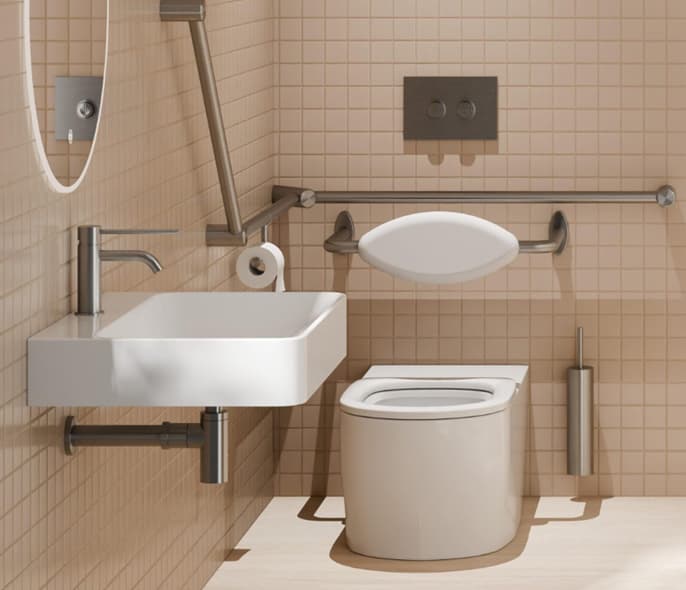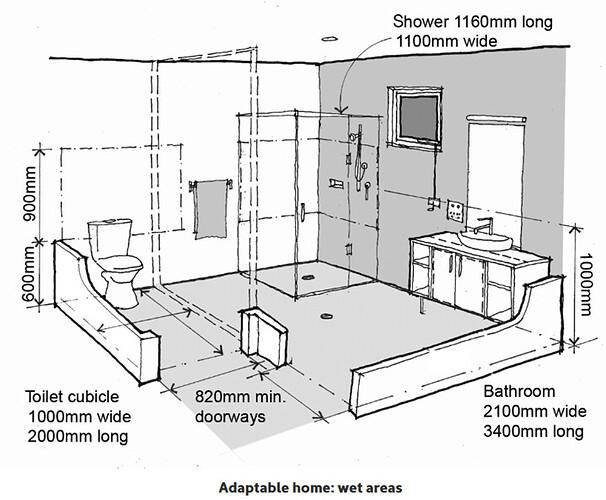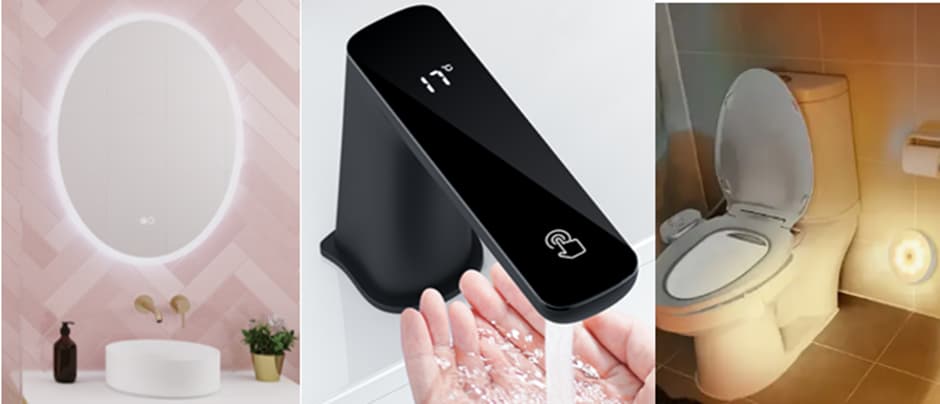Slippery surfaces, small spaces and frustrating fixtures make bathrooms one of the most challenging areas in the home to navigate for people with a disability. This can lead to falls and other injuries. Fortunately, assistive technologies (AT) and bathroom modifications exist to improve independence, safety and accessibility.
For example, here are 5 different bathroom modifications an Occupational Therapist could recommend:
-
Changing the shower for safer access:
- Walk-in showers with no steps or barriers.
- Non-slip flooring to minimise the risks of slips and falls.
- Accessible showerheads for better reach and control.
- Grab rails to increase safety.
-
Toilet modifications to reduce the risk of falls or strain:
- Ambulant or care-style toilet to help with transfers and commode.
- Raised toilet seats for easier sitting and standing.
- Grab rails for safe and stable transfers.
- Bidet seat attachments.
-
Accessible sinks and taps for ease of reach and use:
- Wall-mounted vanities for wheelchair access.
- Hands-free taps with levers or sensors.
- Lower mirrors for viewing while seated.
- Extended tap spouts for washing hands.
-
Improving the bathroom layout for equipment and AT users:
- Widening doorways for wheelchair or walker access.
- Extending the bathroom, ensuring all amenities are in the one wet room.
- Changing the layout of amenities to increase access and independence.
-
Smart technologies for easy use and convenience:
- Voice-activated or motion-sensor lighting.
- Temperature-controlled water taps to prevent burns.
- Emergency alert systems that notify caregivers in case of a fall.
However, NDIS funding for AT or bathroom modifications is subject to eligibility and whether NDIS decide to include them in your Statement of Participant Supports (SOPS). The NDIS will only fund supports if there is sufficient evidence that they relate to impairments arising from your disability. Things that all people, with or without a disability, might want or need, such as a freestanding designer bathtub, are not funded. In addition, each NDIS support must be deemed reasonable and necessary individually, but also when considered as a package of supports.
What is reasonable and necessary is evaluated against the NDIS Rules for Participant Supports, which includes whether supports are:
- Value for money.
- Effective and beneficial and current good practice.
- What is reasonable to expect families, carers, informal networks and community to provide.
- If it will support participants’ goals and allow them to participate in the community.
More information from the NDIS about reasonable and necessary supports can be found here.
Therefore, the more evidence a participant can provide about their need for their supports, the better. Evidence may include:
- Health professionals
- Statements or letters outlining the impact of the disability and the need for specific supports.
- Evidence of current good practice from respectable professionals.
- Carer statements and Statements of Lived Experience
- Explaining how the disability impacts the participant and the level of support they need.
- Evidence of Functional Capacity
- Reports or assessments demonstrating how the impairments reduce a person’s ability to perform daily activities.
- Other documents
- Hospital discharge plans, mental health plans etc.
- Evidence of trials of assistive products
- Evidence of effective and beneficial
- Recent quotes to support value for money
- Quotes for different providers
- Quotes for alternatives for example calculating the cost of a support worker over a year to assist with transfers vs the AT that may remove the need for a support work. (This one is not effective if you will still require a support worker with or without the AT)
- Quotes for alternative products
- A record of the cost of assisting you with falls over the last year that may be eliminated with installation of the AT
Even after all this, the NDIA can decide not to fund your support. A recent example is the funding of emergency lifting chairs such as the Mangar Eagle or Raizer Lifting Chair https://youtu.be/rdiowOJOMhQ?si=7l8Ho23w-OlLptr2. These AT help people who have fallen and are unable to get up by themselves. This technology is especially useful as most falls happen at home, where people spend most of their time and tend to move around without being conscious of safety.
Yes, falls prevention is the preferred risk management approach, and there are many guides and pamphlets covering how to prevent falls inside and outside your home.
The NIA provides a room-by-room guide to preventing falls - https://www.nia.nih.gov/health/falls-and-falls-prevention/preventing-falls-home-room-room.
Closer to home, the Victorian Government has provided precautions to take in and around your home - Preventing falls at home | Better Health Channel and the NSW Government has a booklet on Staying Active and On Your Feet with advice on what to do if you have a fall -https://cdn.activeandhealthy.nsw.gov.au/assets/Uploads/Staying-Active-A4-Oct2018-web.pdf
Notably, these documents focus on preventing falls and how to help yourself or gain the attention of someone who can help, rather than the AT available.
The NDIS website says that lifting chairs are an NDIS support this does not gel with some planners who say lifting devices are excluded because they are “treatments for falling” or not a preventative measure. It may be exceedingly difficult to demonstrate how falling is directly related to your disability and not something that happens to everyone. However, according to the official Australian Government booklet, “Don’t Fall for It. Falls can be prevented!"



